like的用法,be like,would like
- 格式:docx
- 大小:15.71 KB
- 文档页数:2
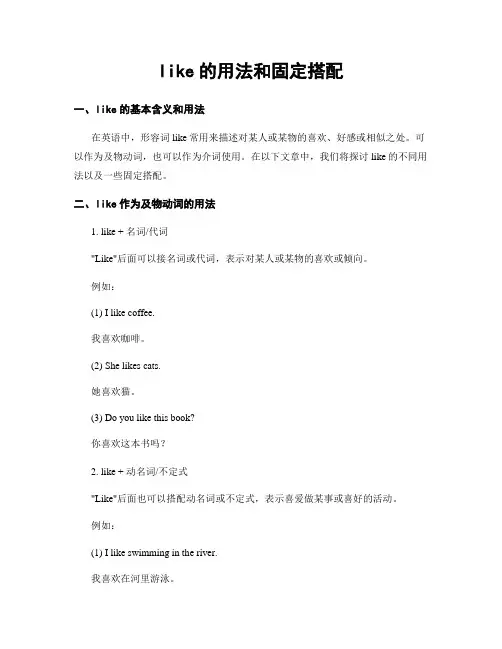
like的用法和固定搭配一、like的基本含义和用法在英语中,形容词like常用来描述对某人或某物的喜欢、好感或相似之处。
可以作为及物动词,也可以作为介词使用。
在以下文章中,我们将探讨like的不同用法以及一些固定搭配。
二、like作为及物动词的用法1. like + 名词/代词"Like"后面可以接名词或代词,表示对某人或某物的喜欢或倾向。
例如:(1) I like coffee.我喜欢咖啡。
(2) She likes cats.她喜欢猫。
(3) Do you like this book?你喜欢这本书吗?2. like + 动名词/不定式"Like"后面也可以搭配动名词或不定式,表示喜爱做某事或喜好的活动。
例如:(1) I like swimming in the river.我喜欢在河里游泳。
(2) He doesn't like to cook.他不喜欢做饭。
3. would like + to do当表达对于未来某个动作的愿望时,可以使用"would like + to do"结构。
它通常用于礼貌地请求或询问意见。
例如:(1) Would you like to have dinner with me?你愿意和我一起吃晚饭吗?(2) I would like to visit Paris someday.我希望有朝一日能够去巴黎。
三、like作为介词的用法1. like + 名词/代词"Like"后面可以接名词或代词,表示类似或相似之处。
例如:(1) She looks like her mother.她长得像她妈妈。
(2) It tastes like chicken.它的味道像鸡肉。
2. be like + 名词/代词当描述某人或某物的特征、性格时,可以使用"be like + 名词/代词"结构。
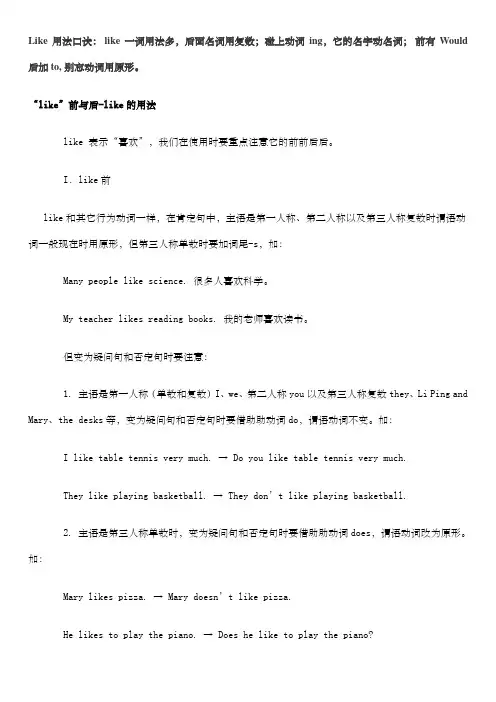
Like用法口诀: like一词用法多,后面名词用复数;碰上动词ing,它的名字动名词;前有Would 后加to, 别忘动词用原形。
“like”前与后-like的用法like 表示“喜欢”,我们在使用时要重点注意它的前前后后。
I.like前like和其它行为动词一样,在肯定句中,主语是第一人称、第二人称以及第三人称复数时谓语动词一般现在时用原形,但第三人称单数时要加词尾-s,如:Many people like science. 很多人喜欢科学。
My teacher likes reading books. 我的老师喜欢读书。
但变为疑问句和否定句时要注意:1. 主语是第一人称(单数和复数)I、we、第二人称you以及第三人称复数they、Li Ping and Mary、the desks等,变为疑问句和否定句时要借助助动词do,谓语动词不变。
如:I like table tennis very much. → Do you like table tennis very much.They like playing basketball. → They don’t like playing basketball.2. 主语是第三人称单数时,变为疑问句和否定句时要借助助动词does,谓语动词改为原形。
如:Mary likes pizza. → Mary doesn’t like pizza.He likes to play the piano. → Does he like to play the piano?II.like后1. like后跟可数名词表示类别时,名词通常用复数形式,不用单数形式。
如:Mary likes dumplings. 玛丽喜欢饺子。
2. like后跟不可数名词时,名词通常用原形。
如:Mike doesn’t like pizza. 迈克不喜欢比撒饼。
3. like后跟动词,要用-ing形式。
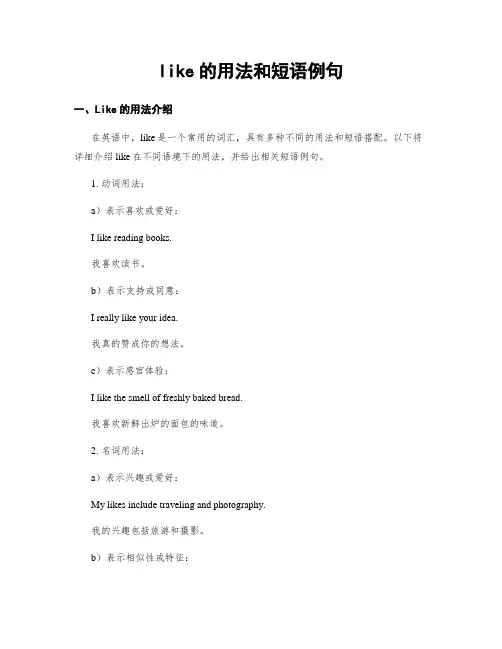
like的用法和短语例句一、Like的用法介绍在英语中,like是一个常用的词汇,具有多种不同的用法和短语搭配。
以下将详细介绍like在不同语境下的用法,并给出相关短语例句。
1. 动词用法:a)表示喜欢或爱好:I like reading books.我喜欢读书。
b)表示支持或同意:I really like your idea.我真的赞成你的想法。
c)表示感官体验:I like the smell of freshly baked bread.我喜欢新鲜出炉的面包的味道。
2. 名词用法:a)表示兴趣或爱好:My likes include traveling and photography.我的兴趣包括旅游和摄影。
b)表示相似性或特征:He has many likes and dislikes.他有许多喜好和厌恶之处。
3. 介词短语:a)像,类似于:She looks like her mother.她看起来像她妈妈。
b)对于,关于:What do you think about cats? I'm not really sure, I don't know much about them.你对猫有什么看法?我不太确定,我对它们了解不多。
c)例如,比方说:We should all try to be more environmentally friendly, like using reusable bags instead of plastic ones.我们应该都尽量更环保一些,比如使用可重复使用的袋子而不是塑料袋。
二、Like的短语例句1. like crazy:I've been studying like crazy for this exam.我为了这次考试拼命地学习。
2. be just like:You look just like your sister.你看起来就像你姐姐。
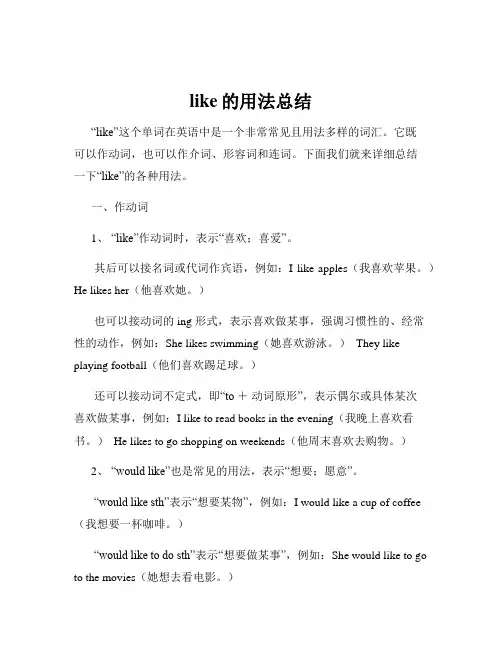
like的用法总结“like”这个单词在英语中是一个非常常见且用法多样的词汇。
它既可以作动词,也可以作介词、形容词和连词。
下面我们就来详细总结一下“like”的各种用法。
一、作动词1、“like”作动词时,表示“喜欢;喜爱”。
其后可以接名词或代词作宾语,例如:I like apples(我喜欢苹果。
)He likes her(他喜欢她。
)也可以接动词的 ing 形式,表示喜欢做某事,强调习惯性的、经常性的动作,例如:She likes swimming(她喜欢游泳。
) They like playing football(他们喜欢踢足球。
)还可以接动词不定式,即“to +动词原形”,表示偶尔或具体某次喜欢做某事,例如:I like to read books in the evening(我晚上喜欢看书。
) He likes to go shopping on weekends(他周末喜欢去购物。
)2、“would like”也是常见的用法,表示“想要;愿意”。
“would like sth”表示“想要某物”,例如:I would like a cup of coffee (我想要一杯咖啡。
)“would like to do sth”表示“想要做某事”,例如:She would like to go to the movies(她想去看电影。
)3、“feel /look like”,表示“感觉/看起来像……”。
例如:It feels like rain(感觉要下雨了。
) He looks like his father (他看起来像他父亲。
)二、作介词1、“like”作介词时,表示“像;如同”。
例如:She is like a flower(她像一朵花。
) It's like a dream(这就像一场梦。
)2、常见的短语“look like”,“sound like”,“taste like”,分别表示“看起来像”,“听起来像”,“尝起来像”。
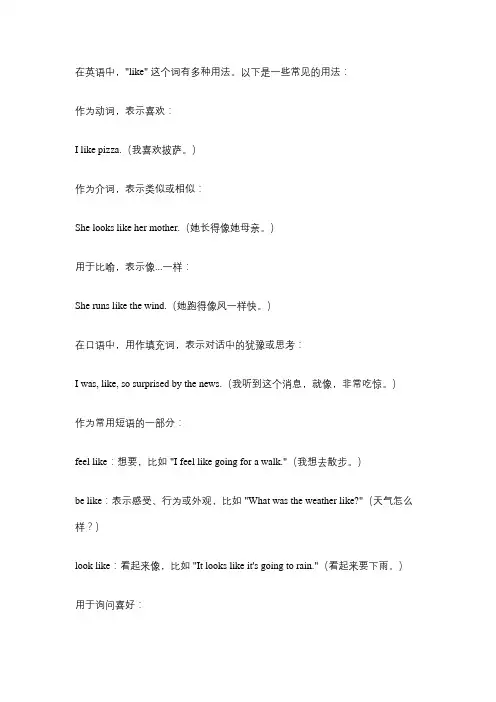
在英语中,"like" 这个词有多种用法。
以下是一些常见的用法:作为动词,表示喜欢:I like pizza.(我喜欢披萨。
)作为介词,表示类似或相似:She looks like her mother.(她长得像她母亲。
)用于比喻,表示像...一样:She runs like the wind.(她跑得像风一样快。
)在口语中,用作填充词,表示对话中的犹豫或思考:I was, like, so surprised by the news.(我听到这个消息,就像,非常吃惊。
)作为常用短语的一部分:feel like:想要,比如 "I feel like going for a walk."(我想去散步。
)be like:表示感受、行为或外观,比如 "What was the weather like?"(天气怎么样?)look like:看起来像,比如 "It looks like it's going to rain."(看起来要下雨。
)用于询问喜好:What does she like?(她喜欢什么?)用于比较:She likes listening to music more than watching movies.(她更喜欢听音乐,而不是看电影。
)注意:"like" 的用法非常灵活,可以根据上下文和句子结构以及口语或书面语的需求进行改变。
在英语学习过程中,熟练掌握 "like" 的各种用法对提高语言表达能力非常有帮助。
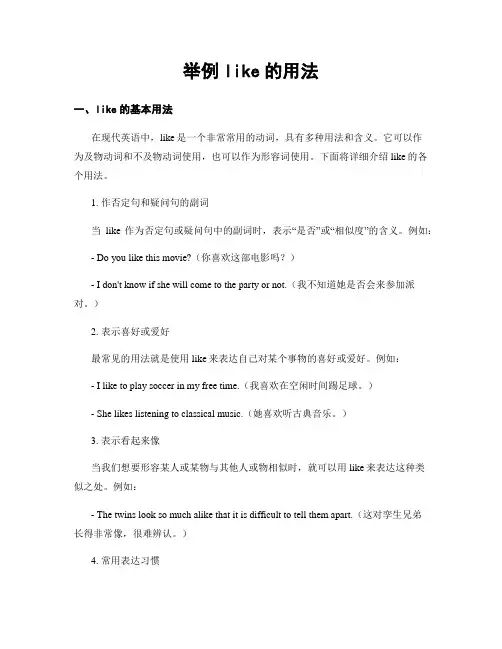
举例like的用法一、like的基本用法在现代英语中,like是一个非常常用的动词,具有多种用法和含义。
它可以作为及物动词和不及物动词使用,也可以作为形容词使用。
下面将详细介绍like的各个用法。
1. 作否定句和疑问句的副词当like作为否定句或疑问句中的副词时,表示“是否”或“相似度”的含义。
例如:- Do you like this movie?(你喜欢这部电影吗?)- I don't know if she will come to the party or not.(我不知道她是否会来参加派对。
)2. 表示喜好或爱好最常见的用法就是使用like来表达自己对某个事物的喜好或爱好。
例如:- I like to play soccer in my free time.(我喜欢在空闲时间踢足球。
)- She likes listening to classical music.(她喜欢听古典音乐。
)3. 表示看起来像当我们想要形容某人或某物与其他人或物相似时,就可以用like来表达这种类似之处。
例如:- The twins look so much alike that it is difficult to tell them apart.(这对孪生兄弟长得非常像,很难辨认。
)4. 常用表达习惯在口语中,like还常用于表达一个人的习惯、倾向或说话的风格。
例如:- She's like always late for meetings.(她总是迟到开会。
)- He's like, "I can't believe you said that!"(他像是说道:“我简直不敢相信你说了那个!”)二、like的短语和固定搭配1. feel like + 名词表示“想要”或“渴望”的意思,类似于want to。
例如:- I feel like a cup of coffee.(我想喝一杯咖啡。
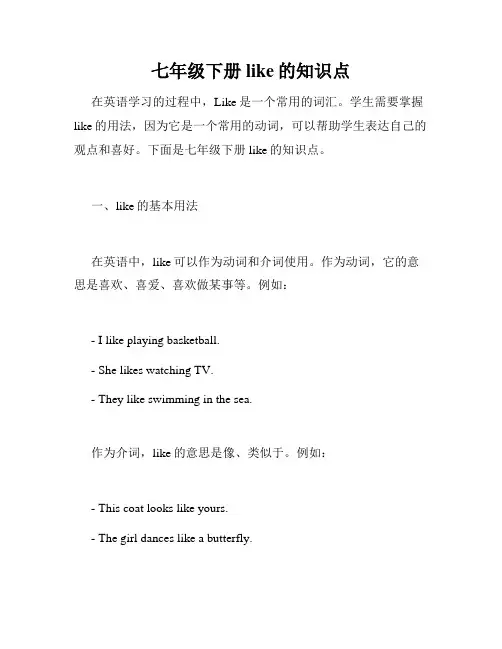
七年级下册like的知识点在英语学习的过程中,Like是一个常用的词汇。
学生需要掌握like的用法,因为它是一个常用的动词,可以帮助学生表达自己的观点和喜好。
下面是七年级下册like的知识点。
一、like的基本用法在英语中,like可以作为动词和介词使用。
作为动词,它的意思是喜欢、喜爱、喜欢做某事等。
例如:- I like playing basketball.- She likes watching TV.- They like swimming in the sea.作为介词,like的意思是像、类似于。
例如:- This coat looks like yours.- The girl dances like a butterfly.二、like的时态变化like的时态变化比较简单,只需要根据主语的不同进行变化即可。
例如:- 一般现在时态:I like playing basketball.- 一般过去时态:He liked playing basketball when he was young.- 现在进行时态:She is liking her new job.- 现在完成时态:They have liked each other for many years.三、like的搭配1. 情态动词can/may/should + like- Can you like spicy food?- May I know if you like tea or coffee?- You should like this movie.2. like + 名词/动名词/不定式- He likes playing video games.- I like watching movies.- You would like to have a cup of tea.3. would like/want/desire/hope/prefer + 名词/动名词/不定式- She would like a glass of water.- I want to eat some fruit.- He desires to travel around the world.- We hope to learn more about English.- They prefer to stay at home today.4. like + to be + 形容词- She likes to be beautiful.- He doesn't like to be late.- They like to be happy.四、like的习惯用语1. What do you like?这是一个常用的问句,意思是“你喜欢什么?”通常用来询问对方的兴趣爱好。

belike和looklike的用法be like和look like的用法:be like意为像…………一样、长得像,主要用于使人愉快但尚不至唤起极大热情或迫切愿望的人与事,使用范围广泛,即可询问性格,又可询问外貌;look like意为看起来与某人相似或相像,侧重于询问外貌。
一、be like的意思及用法介绍be like意为像;像…………一样;长得像。
例句有:1、We want this to be like a home, not an institution.我们希望这里像个家,而不像收容所。
2、I had some idea of what the job would be like.我对于这份工作有了一些了解。
3、She didn't know what life in a foreign country would be like.她不知道外国的生活会是什么样。
4、I tried to picture what it would be like to live alone.我努力设想一个人单独生活是什么情景。
5、Can you imagine what it must be like to lose your job after 20 years?你能想象得出干了20年之后被辞退会是什么样的滋味吗?6、What do you mean you can't do it? It'll be like shooting fish in a barrel!你说干不了是什么意思?这不是小事一桩嘛!二、look like的意思及用法介绍look like意为看起来与(某人或某物)相像或相似;很可能出现或引起(某事、做某事)。
例句有:1、It is smoothly contoured to look like a racing car.这辆车外形设计流畅,看起来像赛车。

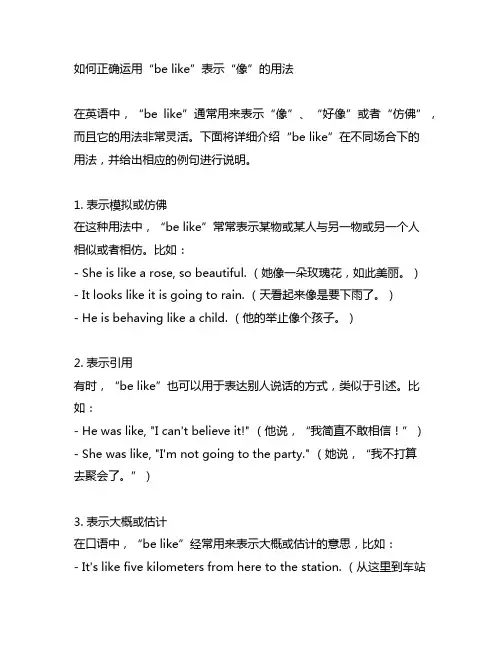
如何正确运用“be like”表示“像”的用法在英语中,“be like”通常用来表示“像”、“好像”或者“仿佛”,而且它的用法非常灵活。
下面将详细介绍“be like”在不同场合下的用法,并给出相应的例句进行说明。
1. 表示模拟或仿佛在这种用法中,“be like”常常表示某物或某人与另一物或另一个人相似或者相仿。
比如:- She is like a rose, so beautiful. (她像一朵玫瑰花,如此美丽。
)- It looks like it is going to rain. (天看起来像是要下雨了。
)- He is behaving like a child. (他的举止像个孩子。
)2. 表示引用有时,“be like”也可以用于表达别人说话的方式,类似于引述。
比如:- He was like, "I can't believe it!" (他说,“我简直不敢相信!”)- She was like, "I'm not going to the party." (她说,“我不打算去聚会了。
”)3. 表示大概或估计在口语中,“be like”经常用来表示大概或估计的意思,比如:- It's like five kilometers from here to the station. (从这里到车站大概有五公里。
)- The movie was like three hours long. (那部电影大概有三个小时长。
)总结回顾通过以上介绍,“be like”在英语中有着多种不同的用法。
它可以表示模拟或仿佛的意思,也可以用于引述别人说话的方式,还可以表示大概或估计。
在实际运用中,我们需要根据具体的语境来灵活使用,并且需要注意不同用法之间的细微差别。
只有在不断的实践和积累中,我们才能更加熟练地运用“be like”这一表达方式。

wouldlike的详细用法今日给大家带来would like的用法,快来一起学习吧,下面我就和大家共享,来观赏一下吧。
would like的用法一、would like的基本用法would like意为“想,想要”,与want意义相同,但语气更委婉。
would like可与任何人称连用,没有人称和数的变化,其后可接名词、代词宾格或动词不定式。
其中,would是情态动词,常可缩写为’d。
如:Lucy would like some eggs.露茜想要一些鸡蛋。
We’d like to watch TV after school.放学之后,我们想要看电视。
二、would like的固定句型1.Would you like some…? 你想要一些……吗?该句型常用于征求对方的看法。
确定回答常用“Yes,please.”,而否定回答常用“No,thanks.”需要特殊留意的是,在该句型中要用some,而不用any,以表示说话人盼望得到确定回答。
如:——Would you like some apples?你想要一些苹果吗?——Yes,please.是的,我想要。
——No,thanks.不,感谢。
2.Would you like to…?你情愿去做……吗?该句型表示向对方有礼貌地提出建议或发出邀请,其中like可用love替换。
如:——Wouldyoulike/lovetoplayfootballwithme?你想要和我一起踢足球吗?——Yes,I’dlike/loveto.是的,我特别情愿。
——I’dlike/loveto.ButI’mtoobusy.我特别情愿,但我太忙了。
3.Would like to do sth.想要做某事;Would like sb. to do sth.想要某人去做某事。
如:He would like to go out for a walk.他想要出去漫步。
Our parents would like us to study well.我们的父母想要我们好好学习。
Like的用法1、like作介词
(1)like作介词表示“像,与…相似”(be/look like)
例句:You look like your father.
你看起来像你父亲。
He looks like his brother.
他长得像他哥哥。
I've got a sweater just like that.
我有一件和那件一模一样的毛衣。
(2)like作介词表示“比如”
例句:She looks best in bright colors, like red and pink.
她穿鲜亮颜色的衣服最漂亮,如红色和粉色。
2、like作动词,表示"喜欢"
例句:I like your new haircut.
我喜欢你的新发型。
He likes to spend his evenings in front of the television.
他喜欢晚上看电视消磨时间。
I like these but she likes those.
我喜欢这些,而她喜欢那些。
这里需要注意的是like作为动词,当主语是第三人称单数时也会在后面加s,而不是只要表示“喜欢”就用likes.
3、like在有些句型中表示“想要”
(1)would like sth. 想要
例句:I think I'd like the soup for my starter.
我想要一份汤做头盘。
(2)would like to do sth. 想要做例句:I'd like to go to Moscow. 我想去莫斯科。
like的用法总结Like是一个多功能的词语,可以用作介词、动词、名词和连词。
在英语中,它有着广泛的用法,每一种用法都有具体的含义和用法规则。
在下面的总结中,我将详细介绍like的用法。
1.介词like:通过介词like,我们可以表示相似性、比较或表达偏好。
比如:- Your handwriting is like mine.(你的书写和我的相似)- She plays the piano like a professional.(她弹钢琴像个专业人士一样)- I feel like pasta for dinner tonight.(我今晚想吃意大利面)2.动词like:Like还可以用作动词,表示喜欢或者对某事物感兴趣。
例如:- I really like chocolate.(我非常喜欢巧克力)- She likes to read books in her free time.(她喜欢在空闲时间读书)- They like going to the movies on weekends.(他们喜欢在周末去电影院)3.名词like:在名词形式中,like可以表示类似的东西或人。
如:- Birds of prey, like eagles and hawks, have excellent eyesight.(像鹰和鹰隼这样的猛禽有着优良的视力)- He behaves like a child sometimes.(他有时候表现得像个孩子)4.连词like:作为连词,like可以用来引出比喻或类比。
如:- He eats like a horse.(他吃得像一匹马)- I feel like a fish out of water in this new job.(在这份新工作里我像是一条无助的鱼)此外,我们还可以使用like与其他的词组合,形成一些常用的短语和习语。
下面是一些常见的组合形式:- be like: 模拟或描述某人的行为或态度。
like的用法总结归纳一、like的基本用法Like是一个常用的动词,表示喜欢、爱好、相似等意思。
它可以作为及物动词或不及物动词使用,也可以作为介词使用。
1. 作为及物动词使用当like作为及物动词时,后面通常跟着名词或代词。
例如:I like coffee. 我喜欢咖啡。
She likes reading books. 她喜欢读书。
2. 作为不及物动词使用当like作为不及物动词时,通常用于表示某种状态或行为的喜好程度。
例如:He doesn't like to get up early. 他不喜欢早起。
I like to listen to music when I'm driving. 我开车时喜欢听音乐。
3. 作为介词使用当like作为介词使用时,通常表示“像”、“类似于”的意思。
在这种情况下,它后面通常跟着名词或代词。
例如:He looks like his father. 他长得像他父亲。
She sings like a bird. 她唱歌像只鸟儿一样美妙。
二、like的常见搭配1. be likeBe like是一个固定搭配,表示“像……”、“好像……”、“似乎……”等意思。
它通常用于描述某人或某物的外表、特征、性格等。
He is like his father. 他像他父亲。
The weather is like summer. 天气像夏天一样。
2. feel likeFeel like表示“想要……”、“有意愿做……”的意思。
它通常用于表示某种愿望或欲望。
例如:I feel like having a cup of coffee. 我想喝一杯咖啡。
Do you feel like going to the movies tonight? 你今晚想去看电影吗?3. look likeLook like表示“看起来像……”、“长得像……”等意思。
它通常用于描述某人或某物的外表、特征等。
would like的用法would like ”意为“想要”,其语气比用like 婉转些。
具体用法如下:1. 后面接名词或代词,表示“具体要”某样东西。
例如:I'd like two sweaters for my daughters.(我想给我的女儿们买两件毛衣。
)Would you like one of these mooncakes?(你想要一块这样的月饼吗?)2. 后面接动词不定式,表示“愿望,喜爱”,常用于有礼貌地提出邀请、请求或建议。
例如:I would like to drop maths.(我想放弃数学。
)Would you like to come to supper?(你愿意来吃晚饭吗?)3. 当主语是第一人称时,would 可与should 换用,它们都可以缩写为'd ,并且like 也可换成love .例如:I'm sure he would love to come.(我确信他愿意来。
)I should like the red one. (我想要红色的。
)4. “ would like ”后面可以用动词不定式作宾语补足语。
例如:What would you like me to do?(你想要我干什么?)I'd like you to meet my parents,too.(我想要你也见见我的父母。
)我想要一些苹果。
I some apples.I some apples.2. 汤姆想打网球。
Tom tennis.3. 我妈妈想让我早点回家。
My mother home early.【提示】would like意为“想,想要”,与want意义相同,但语气更委婉。
would like可与任何人称连用,没有人称和数的变化,肯定句中would常在主语后面缩写为’d。
肯定句:主语+ would like …一般疑问句:Would + 主语 + like …?特殊疑问句:疑问词+ would + 主语+ like …?基本用法:1. would like sth. “想要某物”。
like知识点总结1. like 作为介词当 like 作为介词时,表示“像……一样”、“和……一样”,用于比较事物之间的相似之处。
例如:- She looks like her mother.- He works like a dog every day.2. like 作为动词Like 也可以作为动词,表示“喜欢”、“喜爱”。
在这种情况下,like 可以后接名词、代词、动名词等形式。
例如:- I like ice cream.- She likes playing basketball.3. like 作为名词Like 还可以作为名词,表示“相似之物”、“类似之人”,常与 be 连用。
例如:- Birds of a feather flock together.4. like 作为连词Like 也可以用作连词,引导一个并列的名词短语或从句。
例如:- She enjoys outdoor activities, like hiking and camping.5. like 作为形容词当 like 作为形容词时,表示“相似的”、“类似的”。
例如:- She has a likeable personality.6. like 的其他常见用法- Would you like...? 表示“你想要……吗?”- Be like 表示“像是……”、“好像……”、“说……的话”- Look like 表示“看起来像……”- Feel like 表示“感觉像是……”、“想要……”总的来说,like 是一个非常灵活多用的词语,可以表示各种不同的含义,包括喜欢、相似、比方、如同等。
通过对 like 的不同用法的掌握,读者可以更准确地表达自己的意思,避免使用错误。
希望本篇文章对于读者有所帮助,如果还有其他关于 like 用法的疑问,请随时向我咨询。
小升初英语考点
★考题一like的用法
①like 动词‘喜欢,喜爱’
❈like sth/sb 喜欢某物/某人注意:此时名词用复数,表示喜欢某一类物品如:She likes apple s.
I like you[宾格].
❈like to do/doing sth 喜欢做某事
如:I like read ing stories.
I like to read stories.
②would like ‘想要’
❈would like sth想要某物
如:I would like an apple.
❈would like to do sth 想要做某事(此时的like后面必须用like to do)如:I would like to eat an apple.
[拓展]would like用法适用于want的用法
③like 介词‘像..’
be like 像...一样【问性格】
look like看起来像【问外貌】
be like范围更大一些,有时候既问性格也问外貌
如:--What is he like? 他人怎么样?/ 他长什么样?
--He is friendly./ -- He is tall and thin.
--What does he look like? 他长什么样?
-- He is tall and thin.
对天气的询问
What's the weather like? 此时的like是介词
It's rainy.
试一试:
一、用所给词的适当形式填空
1.I like________(play)football.
2.I_____(not)like_______(eat)apples.
3.He_____(like)______(draw)pictures.
4.She______(not)like_____(read) books.
5.They_______(like)to____(play)football.
二、单项选择
1. --What does he ____like? --He is old.
A./
B. is
C.look
2. --What __ Mike like? --He is polite.
A.look
B. is
C.are
3. What ____ the weather like yesterday?
A.was
B.is
C.do
4. What ___she like? She likes playing football.
A.do
B.does
C.is
5.--Would you like some cake?--______.
A.Yes, I isn’t
B.No,I don’t
C.No,thanks
三、完成下列句子
1.Do you want to go shopping with me?(变同义句)______you______to______shopping with me?
2.I would like some ice cream.(对画线部分提问)
____________you______?
3.Mike likes drawing pictures in the park.
否定句_____________________________
一般疑问句___________________________
对划线部分提问_______________________
参考答案:
一、
1.to play/playing
2.don’t; to eat/don’t; eating
3.likes;to draw/likes;drawing
4.doesn’t reading/doesn’t reading
5.like;play
二、CBABC
三、1.Would;like;go
2.What;would;like
3.Mike doesn’t like drawing pictures in the park.
Does Mike like drawing pictures in the park?
What does Mike like doing in the park?。